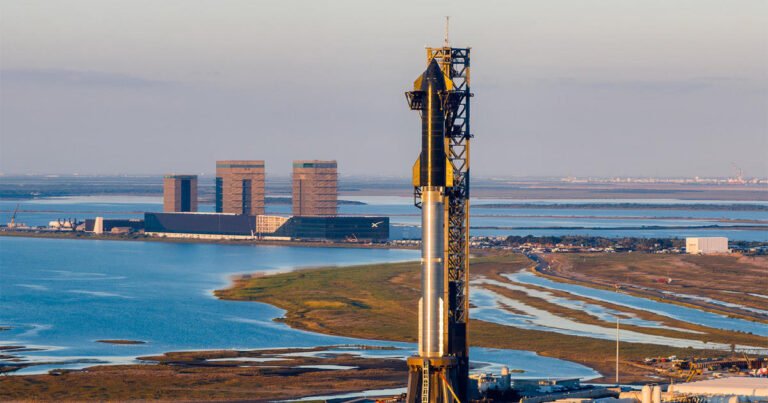
With President-elect Donald Trump and SpaceX CEO/newly-minted efficiency czar Elon Musk expected to be looking on, SpaceX plans to launch the world’s most powerful rocket today on its sixth test flight — a ground-shaking sub-orbital launch of a gargantuan Super Heavy-Starship to evaluate critical upgrades.
What time will the SpaceX Starship launch take place?
Liftoff of the 30-foot-wide, 397-foot-tall rocket from Musk’s sprawling Boca Chica, Texas, manufacturing and test facility on the Gulf Coast near Brownsville is targeted for 5 p.m. EST, the opening of a 30-minute launch window.
As with the rocket’s fifth test flight last month, the primary goals of Tuesday’s flight remained the same: to boost the Starship out of the lower atmosphere on a sub-orbital flight to re-entry over the Indian Ocean while the Super Heavy booster flies itself back to the launch pad where giant mechanical arms will pluck it out of mid air.
SpaceX
Will Trump attend the SpaceX Starship launch?
Trump planned to fly to south Texas to witness the launch, sources familiar with the plans told CBS News. Trump mentioned the new rocket in a Sept. 21 campaign speech in Wilmington, North Carolina, urging Musk to “get those rocket ships going because we want to reach Mars before the end of my term. We want to do it.”
What’s different about launch 6 than the previous 5 launches?
This time around, one of the Starship’s methane-burning Raptor engines will be re-started in space to demonstrate the propulsion system’s ability to perform critical maneuvers and future de-orbit burns.
Engineers also are testing “a suite of heatshield experiments and maneuvering changes for ship reentry and descent over the Indian Ocean,” SpaceX said on its web page, along with software and booster hardware upgrades intended to add additional propulsion system redundancy and increase the rocket’s structural strength.
The October test flight was the first featuring a successful launch pad “catch” and the first with a Starship that reached the Indian Ocean essentially intact.
For Tuesday’s flight, launch was moved to the late afternoon in Texas to ensure a daylight splashdown for video documentation.
Plans for the Super Heavy-Starship
The Super Heavy-Starship is the centerpiece of Musk’s drive to develop a fully reusable heavy-lift rocket, which he says is the key to making humanity “multi-planetary.” And now, with Trump’s support, he may be able to kick start that effort.
Shortly after winning the presidential election, Trump announced that Musk and one-time presidential contender Vivek Ramaswamy would lead a new agency known as the Department of Government Efficiency. The goal, Trump said in a statement, is to “dismantle government bureaucracy, slash excess regulation, cut wasteful expenditures and restructure federal agencies.”
Musk said in the same statement: “This will send shockwaves through the system, and anyone involved in government waste, which is a lot of people.”
SpaceX already holds billions in government contracts and is building a variant of the Starship to serve as the initial lunar lander in NASA’s Artemis moon program. It remains to be seen how Musk’s role in the new administration might advance SpaceX’s plans or how questions about conflicts of interest might be resolved.
Politics aside, “we are looking at a serious effort to return to the moon, and maybe a serious effort … to send, if not humans to Mars in the next four years, a lot of stuff and a lot of infrastructure that will enable humans to get to Mars,” said Casey Drier, director of space policy for the Planetary Society.
“Maybe not in four years, but maybe in the next 10.”
The key to those plans is the Super Heavy-Starship.
How does the Super Heavy-Starship work?
The Super Heavy booster is powered by 33 Raptor engines burning liquid methane and oxygen to generate more than 16 million pounds of thrust at full throttle, more than twice the liftoff power of NASA’s legendary Saturn 5 moon rocket. The Starship is powered by six Raptors and will be capable of carrying astronauts, satellites and science probes.
Like the company’s workhorse Falcon 9 rocket, the 230-foot-tall first stage is designed to be fully reusable, flying itself back to the launch pad where giant “chopsticks” mounted on the pad gantry can catch the booster as it descends, enabling rapid servicing, re-fueling and launch.
Unlike the Falcon 9, which uses a throw-away second stage, the 160-foot-tall Starship also is reusable, capable of safely returning to Earth after launching satellites or carrying astronauts to the moon and eventually, Musk says, to Mars.
SpaceX already ferries astronauts and cosmonauts to and from the International Space Station using Falcon 9s carrying the company’s Crew Dragon spacecraft and is building a variant of the Starship for NASA to carry astronauts back to the moon’s surface in the 2026-27 timeframe.
The company also launches commercial and military satellites, is building a powerful space tug for NASA to help drive the International Space Station safely out of orbit when the program is retired in 2030 and is launching thousands of its own Starlink satellites to provide global access to the internet.
“SpaceX functionally has the monopoly on access to space,” said Drier. “Pretty much any asset that you want to launch into space, whether you’re the U.S. government or commercial provider, a satellite company, even the European Space Agency, they are all using SpaceX rockets.”
